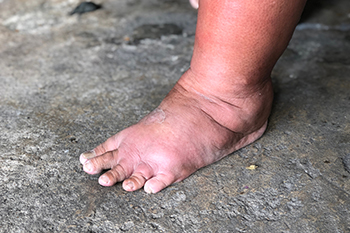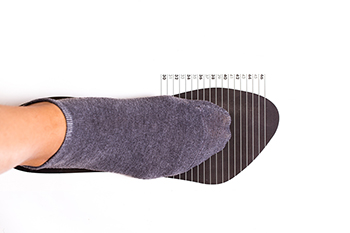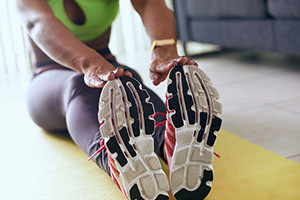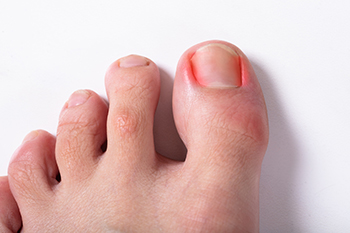Connect With Us
Blog
Items filtered by date: October 2023
Reasons for Swollen Feet

Swollen feet can cause both inconvenience and discomfort, but ignoring them may be dangerous, as edema can be a symptom of an underlying condition. One of the most common causes of swollen feet is pregnancy, which can be the result of increased fluid retention and hormonal changes. Injuries to the leg or ankle can lead to swelling, as ligaments stretch beyond their normal range of motion. Lymphedema, another cause of swelling, results from the accumulation of lymphatic fluid, often after cancer radiation therapy or lymph node removal. Venous insufficiency, which stems from damaged vein valves in the legs and feet, can also cause the feet to swell, and can be accompanied by potential symptoms such as ulcers and skin discoloration. Infections pose a risk, especially for those with diabetic neuropathy or nerve problems, making regular foot exams with a podiatrist essential for diabetics patients. Certain medications can induce foot swelling as a side effect, necessitating consultation with a podiatrist. Arthritis can affect joints, causing swelling as a result of increased synovial fluid or inflammation. While mild foot swelling may not always warrant medical attention, chest pain, breathing difficulties, or shortness of breath require immediate evaluation as they may indicate pulmonary edema. If you notice sudden or unusual swelling in your feet, it is strongly suggested that you make an appointment with a podiatrist at your earliest opportunity.
Swollen feet can be a sign of an underlying condition. If you have any concerns, contact Afsha Naimat-Shahzad, DPM of Leander Foot & Ankle. Our doctor can provide the care you need to keep you pain-free and on your feet.
Swollen feet are a common ailment among pregnant women and people who stand or sit for extended periods. Aging may increase the possibility of swollen feet and patients who are obese often notice when their feet are swelling too. There may be medical reasons why swollen feet occur:
- Phlebitis - A condition that causes the veins to become inflamed and can also cause leg pain.
- Liver disease - This may lead to low blood levels of albumin which is a protein. This can cause fluid in the blood to pass into the tissues and several areas of the body can become swollen.
- Heart failure - When the heart doesn’t pump properly the blood that is normally pumped back to the heart can pool in the veins of the legs causing swollen feet.
- Kidney disease - One of the main functions of the kidneys is releasing excess fluid in the body. This type of condition can make it difficult for the kidneys to function properly, and as a result the feet may become swollen.
- Deep-vein thrombosis (DVT)- This is a serious condition where blood clots form in the veins of the legs. They can block the return of blood from the legs to the heart which may cause the feet to swell. It is important to be treated by a podiatrist if this condition is present.
Swollen feet can also be caused by bone and tendon conditions, including fractures, arthritis, and tendinitis. Additionally, there may be skin and toenail conditions and an infection may cause the feet to swell. Patients who take medicine to treat high blood pressure may be prone to getting swollen feet.
Many patients elevate their feet to help relieve the swelling and this is generally a temporary remedy. When a podiatrist is consulted the reason behind the swelling can be uncovered and subsequently treated.
If you have any questions please feel free to contact our office located in Leander, TX . We offer the newest diagnostic tools and technology to treat your foot and ankle needs.
Ensuring a Proper Fit for Shoes and Boots

The key to comfortable footwear lies in getting the right fit. Ill-fitting shoes or boots can lead to a host of issues, including blisters, calluses, and chronic foot problems. To ensure your footwear provides the perfect fit, begin by measuring your feet regularly, as their size can change over time. Always try on both shoes and shop in the afternoon when your feet are slightly larger due to daily activities. Consider the type of socks you will be wearing with your shoes, as this can affect the fit. Pay attention to how the shoes or boots feel, ensuring there is enough space in the toe box, and that your heels do not slip. Walk around in them to test comfort and stability. Lastly, remember that sizes can vary between brands and styles, so rely more on the fit and feel than the size on the label. If you would like additional tips on how to buy shoes that fit properly, it is suggested that you contact a podiatrist who can provide you with the information you are seeking.
Finding a properly-fitting shoe is important in reducing injuries and preventing foot problems. For more information about treatment, contact Afsha Naimat-Shahzad, DPM from Leander Foot & Ankle. Our doctor will treat your foot and ankle needs.
Proper Shoe Fitting
A common concern when it comes to foot health, having properly fitted shoes can help prevent injuries to the foot. Out feet affect our posture and gait, which in turn affects the biomechanics and overall bodily structure. With 33 joints, 26 bones, and over 100 ligaments, the potential for serious injury is much greater than one realizes. Although the feet cease growth in adulthood, they still change shape as they mature. Here are some factors to consider when it comes to investing in proper fitting shoes:
- Be sure the shoes fit correctly right away
- Ensure the ball of your foot fits comfortably in the widest portion of the shoes
- Even though they may look fashionable, improper fitting shoes can either create adverse conditions or exacerbate existing ones you may already have
- Walk along a carpeted surface to ensure the shoes comfortably fit during normal activity
Keeping in mind how shoes fit the biomechanics of your body, properly-fitting shoes are vitally important. Fortunately, it is not difficult to acquire footwear that fits correctly. Be sure to wear shoes that support the overall structure of your body. Do your feet a favor and invest in several pairs of well-fitted shoes today.
If you have any questions please feel free to contact our office located in Leander, TX . We offer the newest diagnostic and treatment technologies for all your foot and ankle needs.
Gout Pain Can Be Managed
Essential Stretches for Runners

Running is an invigorating way to stay fit, but it can put a lot of strain on your muscles and joints. Incorporating proper stretching into your routine is essential to enhance flexibility, reduce the risk of injuries, and improve overall performance. Start with a dynamic warm-up, such as leg swings or high knees, to prepare your muscles for action. Post-run, static stretches can help relieve tension. The classic calf stretch, hamstring stretch, and quadriceps stretch are vital for targeting major running muscle groups. To address hip flexibility, try the pigeon pose or a seated hamstring stretch. It is helpful to remember to focus on your core with exercises like the seated torso twist or the standing hip flexor stretch. Consistency is key, and regularly incorporating these stretches into your running routine can enhance your flexibility. It may also reduce the risk of injuries and contribute to a more comfortable and enjoyable running experience. If you would like additional information about effective running stretches, it is suggested that you consult a podiatrist who can provide you with the information you are seeking.
All runners should take extra precaution when trying to avoid injury. If you have any concerns about your feet, contact Afsha Naimat-Shahzad, DPM of Leander Foot & Ankle. Our doctor will treat your foot and ankle needs.
How to Prevent Running Injuries
There are a lot of mistakes a runner can make prior to a workout that can induce injury. A lot of athletes tend to overstretch before running, instead of saving those workouts for a post-run routine. Deep lunges and hand-to-toe hamstring pulls should be performed after a workout instead of during a warmup. Another common mistake is jumping into an intense routine before your body is physically prepared for it. You should try to ease your way into long-distance running instead of forcing yourself to rush into it.
More Tips for Preventing Injury
- Incorporate Strength Training into Workouts - This will help improve the body’s overall athleticism
- Improve and Maintain Your Flexibility – Stretching everyday will help improve overall performance
- “Warm Up” Before Running and “Cool Down” Afterward – A warm up of 5-10 minutes helps get rid of lactic acid in the muscles and prevents delayed muscle soreness
- Cross-Training is Crucial
- Wear Proper Running Shoes
- Have a Formal Gait Analysis – Poor biomechanics can easily cause injury
If you have any questions, please feel free to contact our office located in Leander, TX . We offer the newest diagnostic and treatment technologies for all your foot care needs.
Causes and Symptoms of Toenail Fungus

Toenail fungus, known as onychomycosis, is a common condition that results from exposure to an overgrowth of certain fungi in your toenails. These fungi, including dermatophytes and yeast, can be found naturally on the skin or in the environment, possibly as airborne spores. A contributing factor to toenail fungus is a warm and humid environment that promotes fungal growth. If your feet remain damp or sweaty for extended periods, these microbes can thrive and rapidly multiply, leading to an infection. Moreover, any crack or tear in the skin or nail can provide an entry point for the fungi, allowing them to penetrate deeper into the tissue. As the infection progresses, fungal debris accumulates under the nail, causing it to thicken and change color, typically turning yellow, brown, or white. Cracks may develop in the affected nail as it weakens. This infection can become progressively severe if left untreated. Recognizing the common symptoms early and seeking prompt treatment from a podiatrist is essential. If you believe you have toenail fungus, it is suggested that you seek the help of a podiatrist as quickly as possible.
If left untreated, toenail fungus may spread to other toenails, skin, or even fingernails. If you suspect you have toenail fungus it is important to seek treatment right away. For more information about treatment, contact Afsha Naimat-Shahzad, DPM of Leander Foot & Ankle. Our doctor can provide the care you need to keep you pain-free and on your feet.
Symptoms
- Warped or oddly shaped nails
- Yellowish nails
- Loose/separated nail
- Buildup of bits and pieces of nail fragments under the nail
- Brittle, broken, thickened nail
Treatment
If self-care strategies and over-the-counter medications does not help your fungus, your podiatrist may give you a prescription drug instead. Even if you find relief from your toenail fungus symptoms, you may experience a repeat infection in the future.
Prevention
In order to prevent getting toenail fungus in the future, you should always make sure to wash your feet with soap and water. After washing, it is important to dry your feet thoroughly especially in between the toes. When trimming your toenails, be sure to trim straight across instead of in a rounded shape. It is crucial not to cover up discolored nails with nail polish because that will prevent your nail from being able to “breathe”.
In some cases, surgical procedure may be needed to remove the toenail fungus. Consult with your podiatrist about the best treatment options for your case of toenail fungus.
If you have any questions, please feel free to contact our office located in Leander, TX . We offer the newest diagnostic and treatment technologies for all your foot care needs.
Do Not Ignore Ingrown Toenails

Even if it does not cause pain, it is recommended that one does not ignore an ingrown toenail. Ingrown toenails happen when the corner or side of the toenail grows into the surrounding flesh, leading to pain, discomfort, inflammation, and sometimes infection. Initially a minor annoyance, untreated ingrown toenails can escalate into a recurring and serious issue. Treatment methods depend on the ingrown toenail's severity, the presence of infection, and previous treatments that were attempted. Routine podiatry care, including toenail trimming and addressing underlying issues, can help prevent infected ingrown toenails. Options range from daily foot soaking and antibiotics to more invasive nail avulsion procedures, which involve removing the affected toenail. If you have an ingrown toenail, it is strongly suggested that you make an appointment with a podiatrist for treatment.
Ingrown toenails can become painful if they are not treated properly. For more information about ingrown toenails, contact Afsha Naimat-Shahzad, DPM of Leander Foot & Ankle. Our doctor can provide the care you need to keep you pain-free and on your feet.
Ingrown Toenails
Ingrown toenails occur when a toenail grows sideways into the bed of the nail, causing pain, swelling, and possibly infection.
Causes
- Bacterial infections
- Improper nail cutting such as cutting it too short or not straight across
- Trauma to the toe, such as stubbing, which causes the nail to grow back irregularly
- Ill-fitting shoes that bunch the toes too close together
- Genetic predisposition
Prevention
Because ingrown toenails are not something found outside of shoe-wearing cultures, going barefoot as often as possible will decrease the likeliness of developing ingrown toenails. Wearing proper fitting shoes and using proper cutting techniques will also help decrease your risk of developing ingrown toenails.
Treatment
Ingrown toenails are a very treatable foot condition. In minor cases, soaking the affected area in salt or antibacterial soaps will not only help with the ingrown nail itself, but also help prevent any infections from occurring. In more severe cases, surgery is an option. In either case, speaking to your podiatrist about this condition will help you get a better understanding of specific treatment options that are right for you.
If you have any questions please feel free to contact our office located in Leander, TX . We offer the newest diagnostic and treatment technologies for all your foot and ankle needs.
Blog Archives
- April 2025
- March 2025
- February 2025
- January 2025
- December 2024
- November 2024
- October 2024
- September 2024
- August 2024
- July 2024
- June 2024
- May 2024
- April 2024
- March 2024
- February 2024
- January 2024
- December 2023
- November 2023
- October 2023
- September 2023
- August 2023
- July 2023
- June 2023
- May 2023
- April 2023
- March 2023
- February 2023
- January 2023
- December 2022
- November 2022
- October 2022
- September 2022
- August 2022


